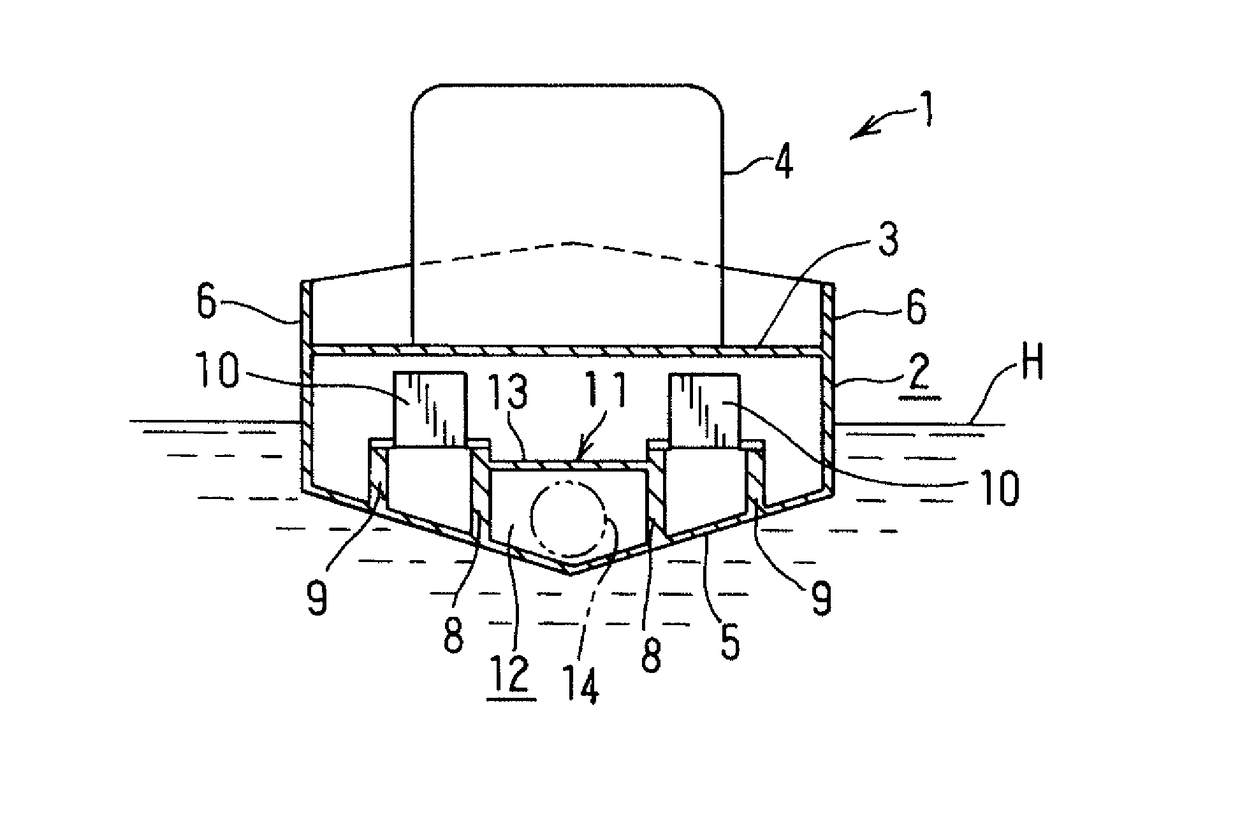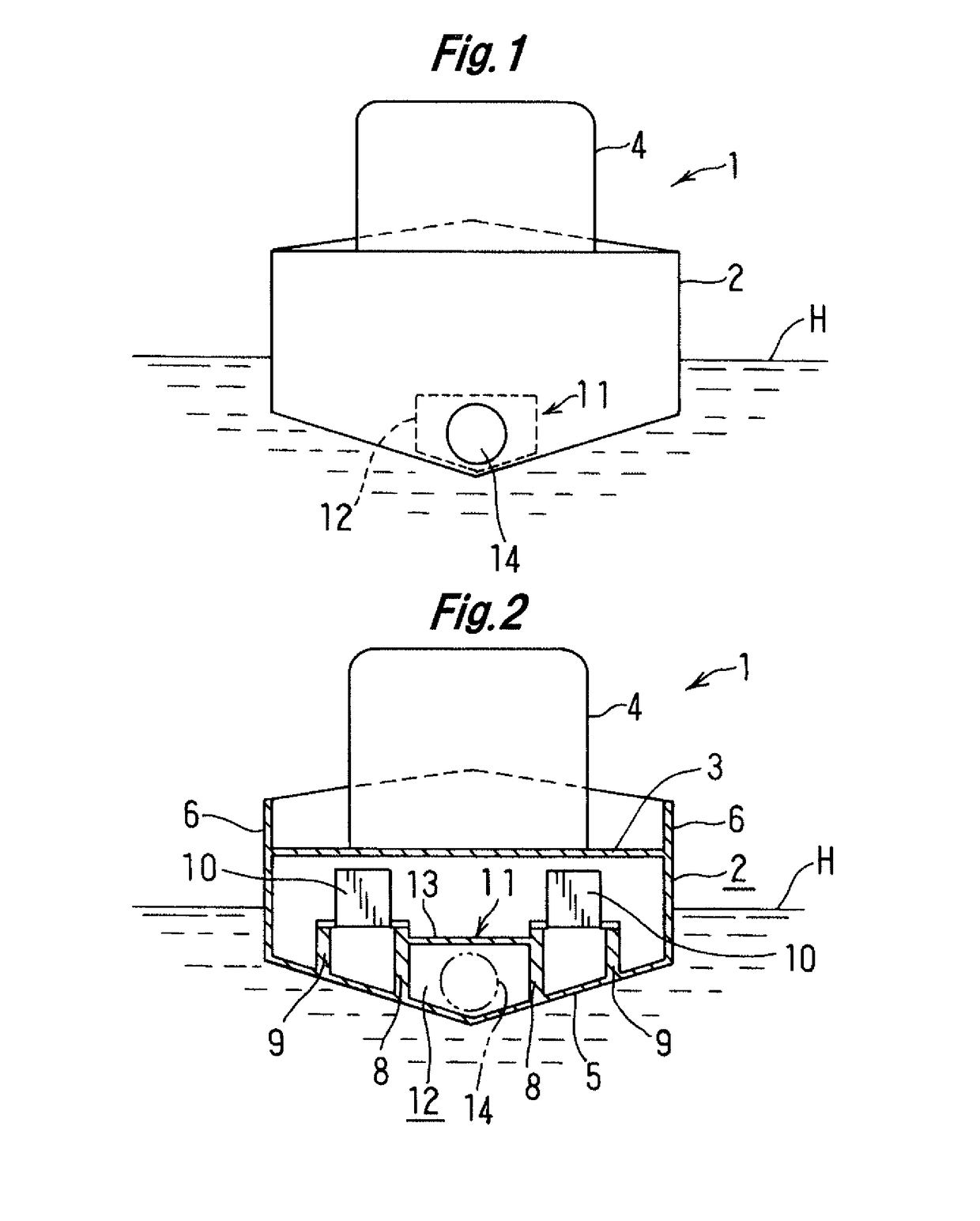Planing boat and method for manufacturing the same
a technology for boating and boating, applied in the field of boating, can solve problems such as and achieve the effect of preventing the boat from rocking
- Summary
- Abstract
- Description
- Claims
- Application Information
AI Technical Summary
Benefits of technology
Problems solved by technology
Method used
Image
Examples
first embodiment
[0035]FIG. 1 to FIG. 3 show a planing boat, when moored, according to the present invention. A boat (1) includes: a hull (2) made of fiberglass reinforced plastic (FRP); a deck (3) made of FRP and joined to an outer edge of an upper portion of the hull (2); and a cabin (4) provided to project from the deck (3).
[0036]The hull (2) includes: a bottom plate (5) that forms the bottom of the boat; right and left side plates (6) that form the sides of the boat and a bow; a transom plate (7) that forms a stern; and four longitudinal vertical plates (8) and (9) each extending between the transom plate (7) and forward portions of the right and left side plates (6) along a sailing direction and each having a lower surface that is fixed to an upper surface of the bottom plate (5).
[0037]The four longitudinal vertical plates (8) and (9) are arranged symmetrically in the right and left direction. Between each pair of the longitudinal vertical plates (8) and (9), an engine (10) supported by an engi...
second embodiment
[0046]FIG. 6 to FIG. 8 show a boat, when moored, according to the present invention.
[0047]A boat (20) according to the second embodiment differs from the boat (1) according to the first embodiment in that an engine (26) is provided at the center in the right and left direction. The shape of the hull (2), including the longitudinal vertical plates (8) and (9), is the same as that of the first embodiment.
[0048]The boat (20) as described above has the same structure of the conventional planing boat, but the planing boat (20) in accordance with the present invention further includes an anti-rocking device (21).
[0049]The anti-rocking device (21) has right and left tanks (22) for storing water. Between upper ends of each pair of the two longitudinal vertical plates (8) and (9), each pair being provided at the right or left part of the boat (20), a top plate (23) is laid. Each of the two right and left pairs of longitudinal vertical plates (8) and (9), the top plate (23), a part of the bot...
third embodiment
[0054]FIG. 10 shows the boat (during the sailing) according to the present invention. When the boat starts sailing and the sailing speed exceeds a certain value, the bow rises above the surface of the water and the boat starts pushing water away at an area behind the stern, as shown in FIG. 5. At this time, when the closed lid (26) is opened, the boat continues sailing with no water flowing through the through hole (14) into the tank (12).
[0055]In the above embodiments, the longitudinal vertical plates (8) and (9) are not limited to those shown in the drawings, and the tank may be provided by using existing longitudinal vertical plates as appropriate. In addition, when required, any longitudinal material as a separate component may be added for forming the tank.
PUM
 Login to View More
Login to View More Abstract
Description
Claims
Application Information
 Login to View More
Login to View More - R&D
- Intellectual Property
- Life Sciences
- Materials
- Tech Scout
- Unparalleled Data Quality
- Higher Quality Content
- 60% Fewer Hallucinations
Browse by: Latest US Patents, China's latest patents, Technical Efficacy Thesaurus, Application Domain, Technology Topic, Popular Technical Reports.
© 2025 PatSnap. All rights reserved.Legal|Privacy policy|Modern Slavery Act Transparency Statement|Sitemap|About US| Contact US: help@patsnap.com



